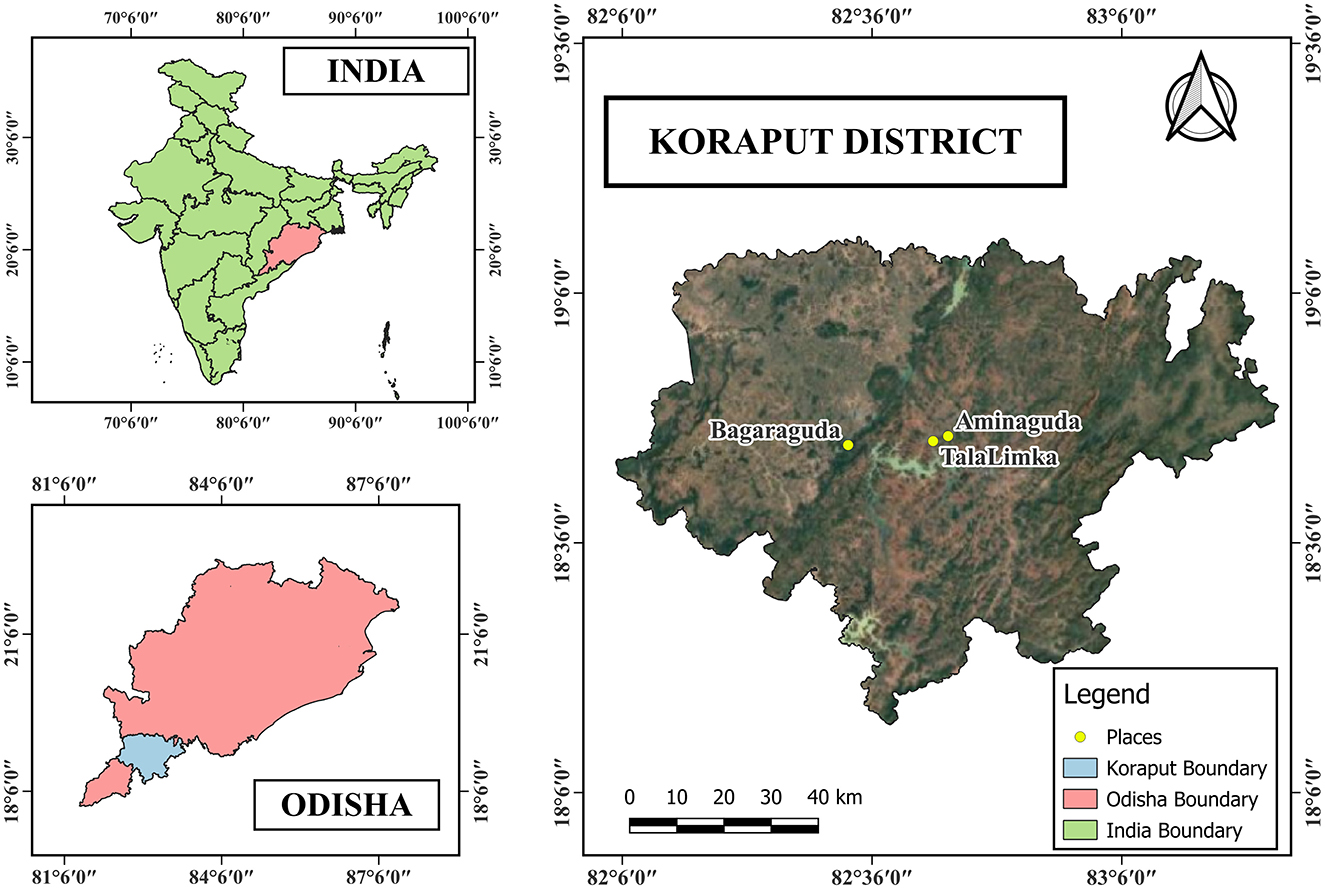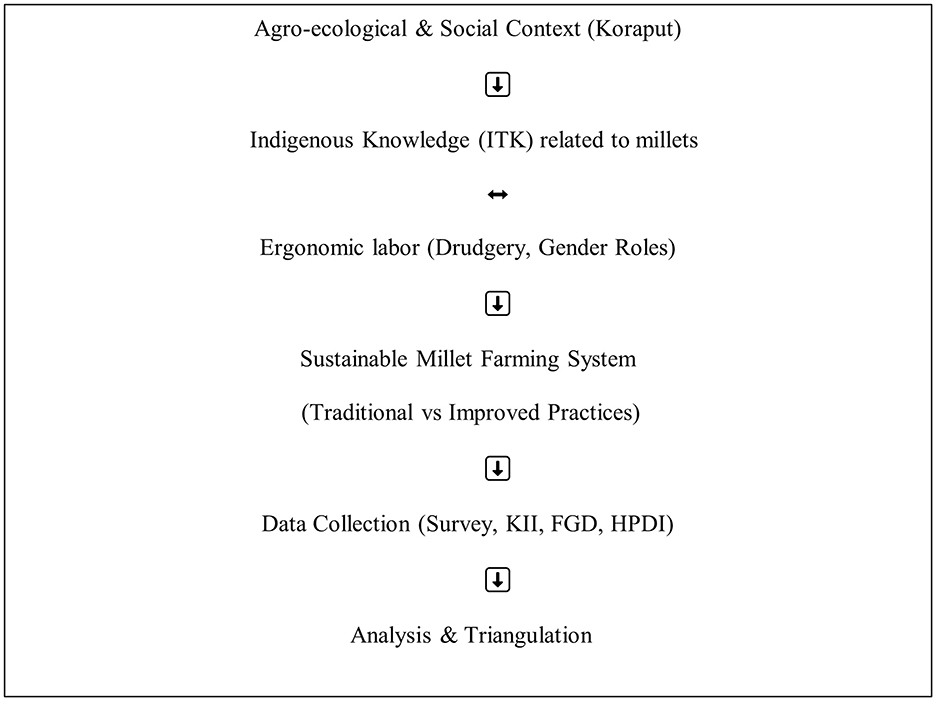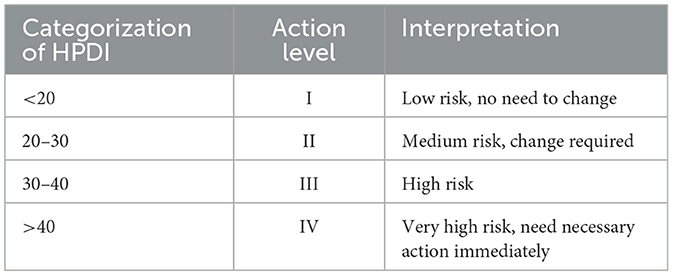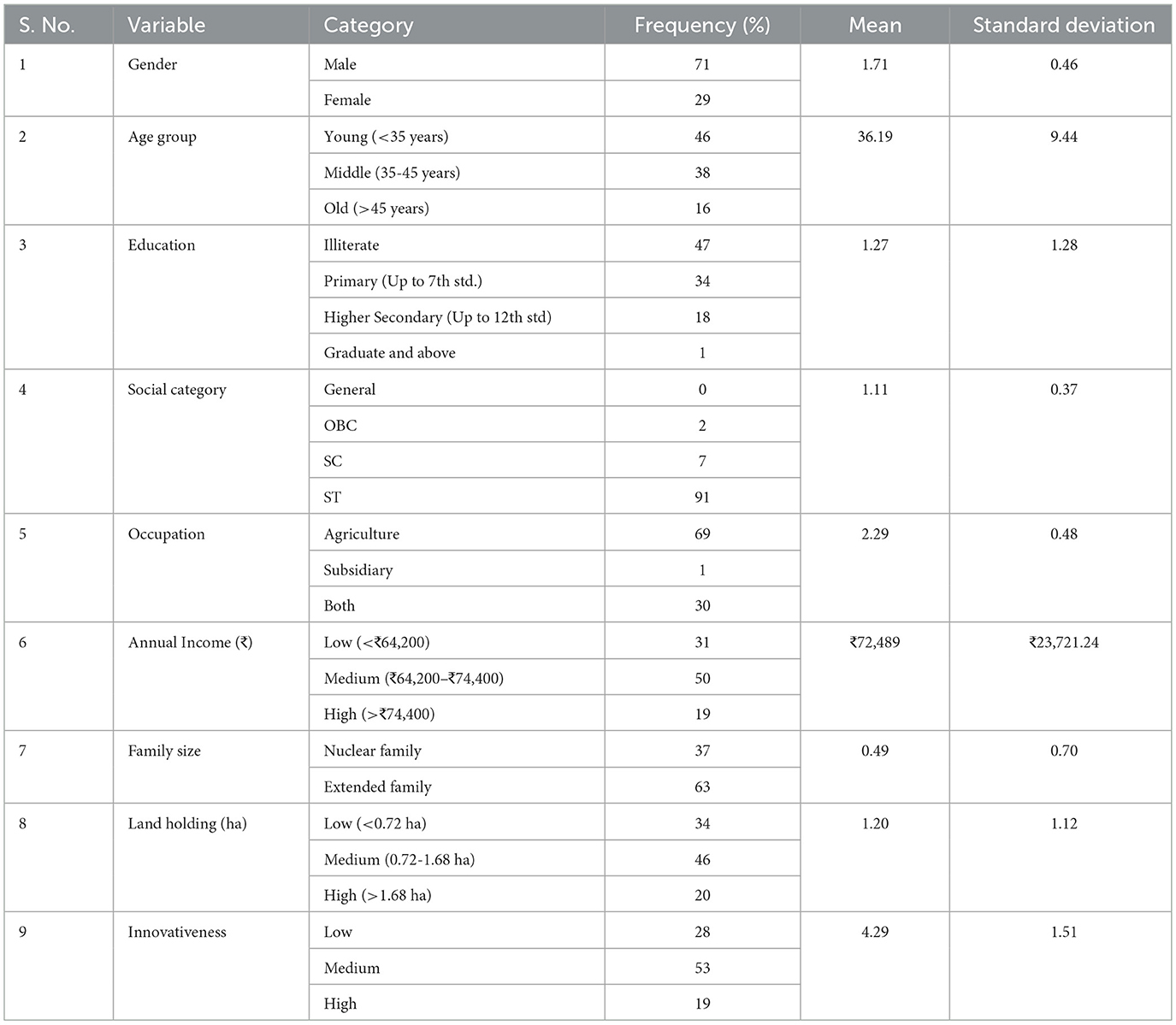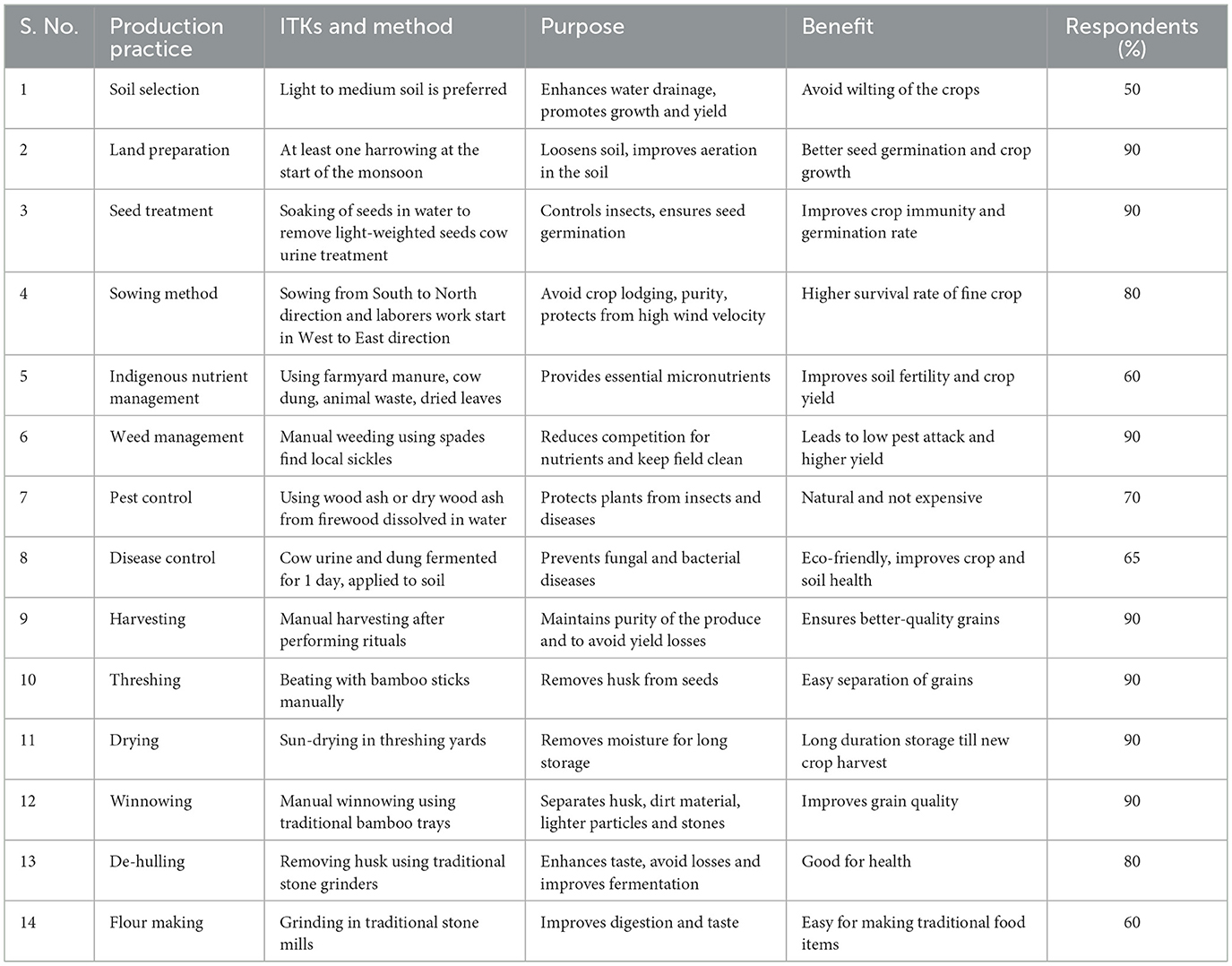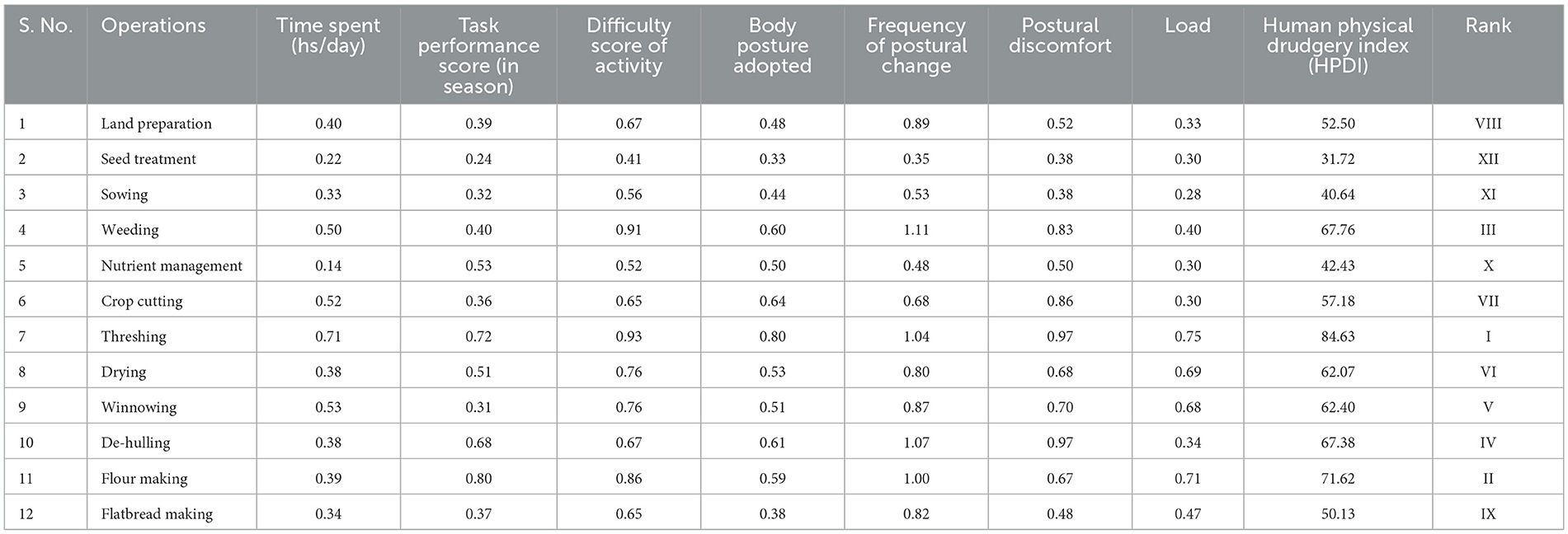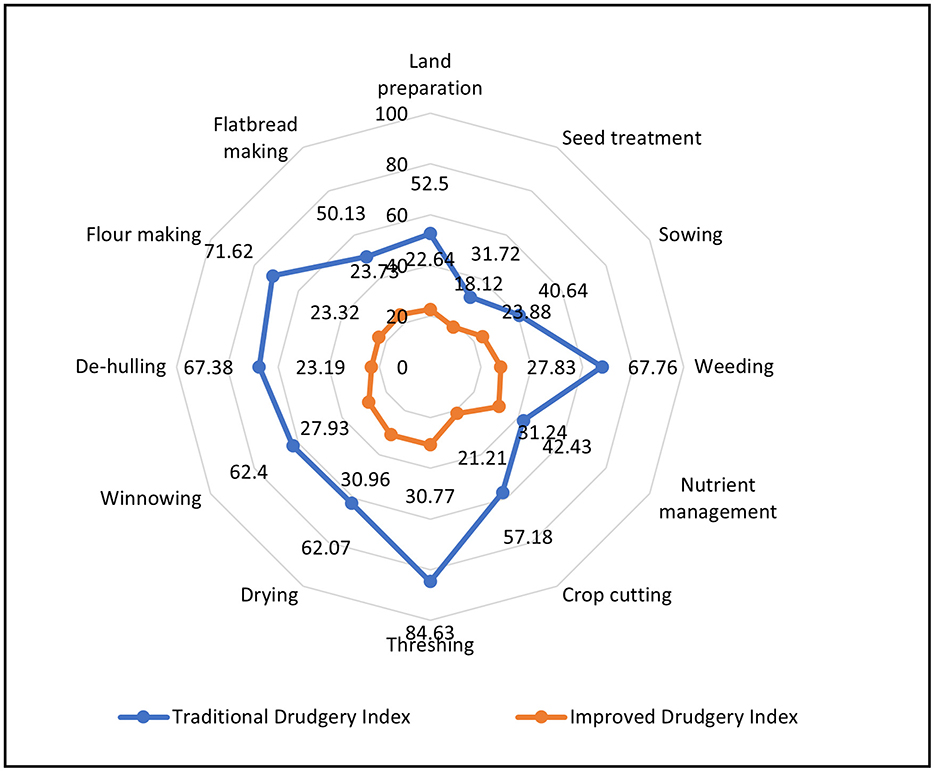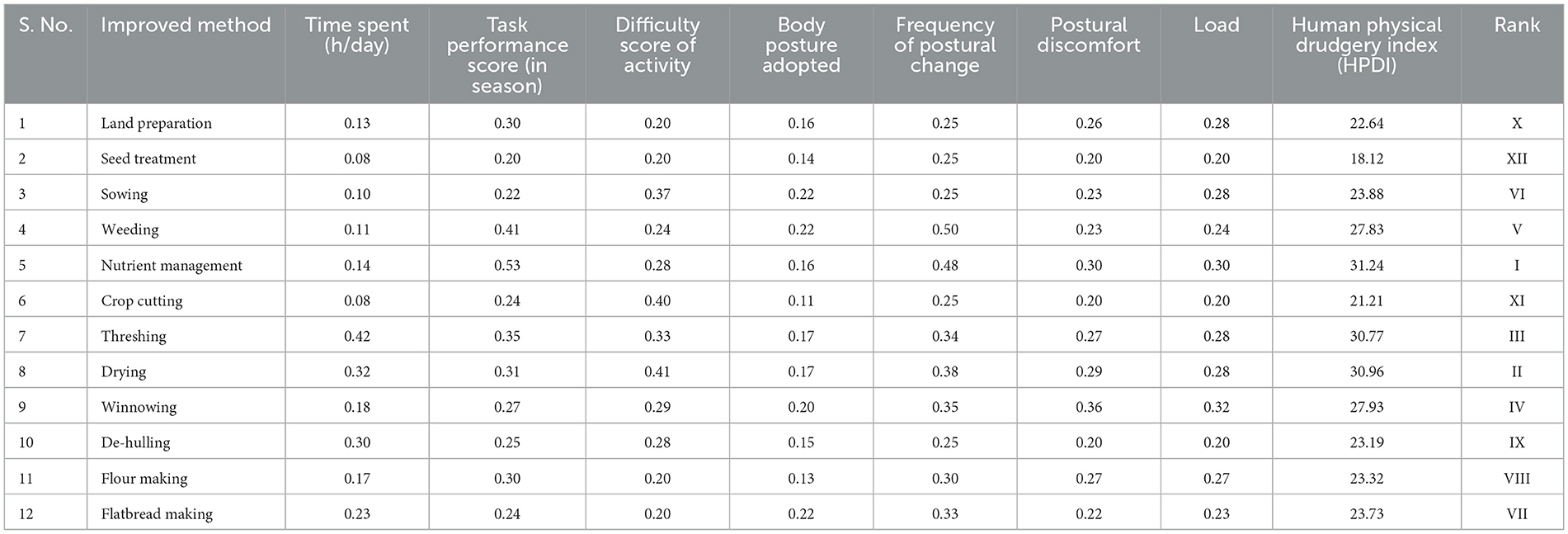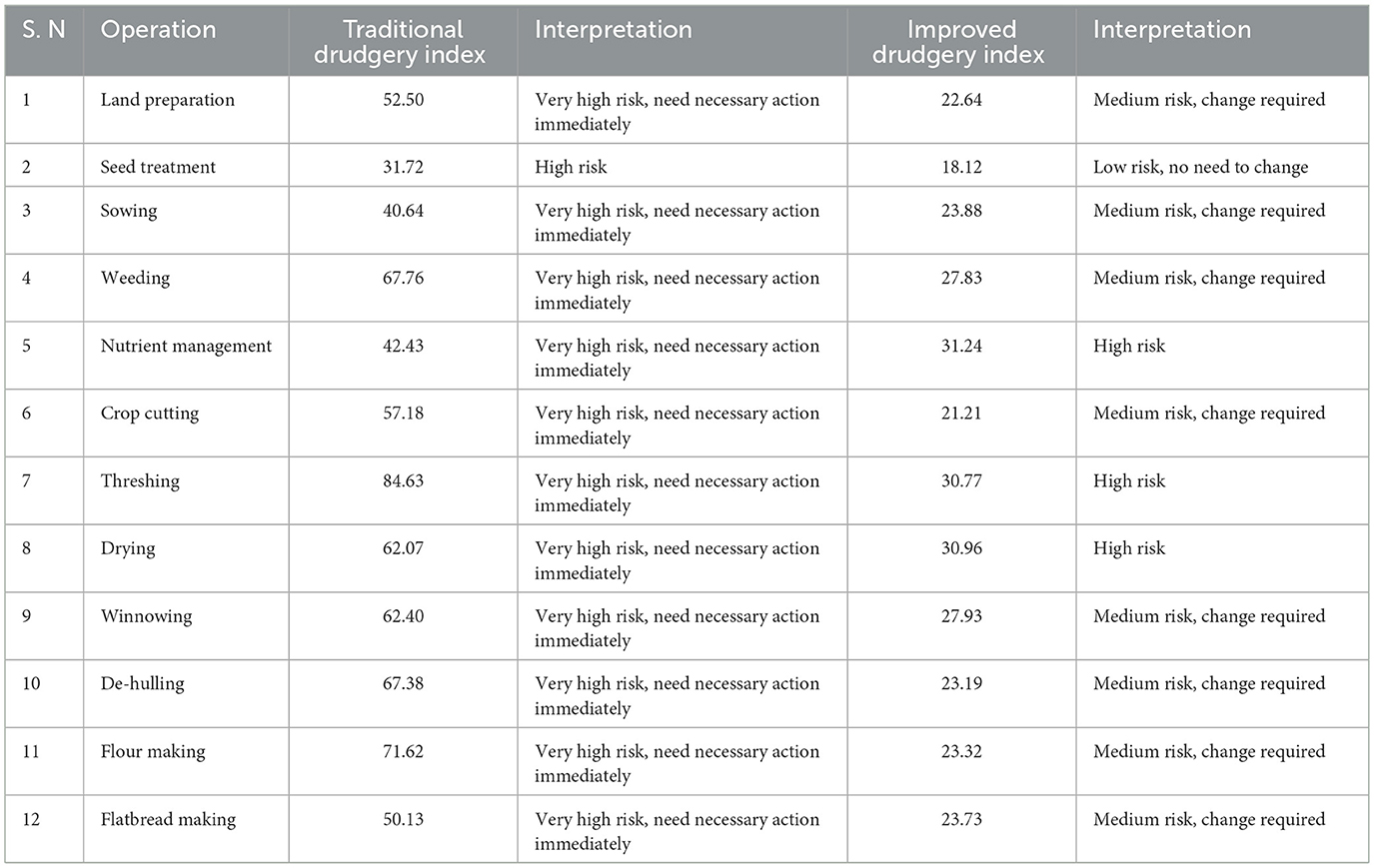- Indian Council of Agricultural Research (ICAR)-Indian Institute of Millets Research (IIMR), Hyderabad, India
Millets offer significant potential for sustainable agriculture in tribal regions, yet the role of Indigenous Traditional Knowledge and the ergonomic burden on farmers, particularly women remain underexplored. This study addresses these gaps by examining the interplay between Indigenous Traditional Knowledge, physical drudgery, and millet farming practices in Koraput, Odisha. Despite wide use of ecologically sound traditional methods, farmers especially women face substantial drudgeries in post-harvest tasks such as threshing, de-hulling, and grinding. A mixed-methods approach was used to collect data from 100 randomly selected tribal farmers across three villages through structured interviews, key informant interviews, focus group discussions, and field observations. The human physical drudgery index was applied to assess ergonomic risks. Findings showed that traditional practices, while sustainable, impose very high physical strain in case of threshing (Drudgery Index = 84.63) and flour making (Drudgery Index = 71.62), ranked as the most drudgery-intensive operations. Improved tools significantly reduced the human physical drudgery index but were underutilized due to affordability, limited access, and cultural preferences. The study highlights the need to integrate validated indigenous traditional knowledge with gender-sensitive ergonomic innovations to enhance sustainability and farmer wellbeing. Policy measures should focus on self-help groups led and or custom hiring services of the machinery, expanding participatory extension, and subsidies for women-friendly equipment. Reducing drudgery while preserving traditional knowledge is key to resilient and inclusive millet-based farming systems.
1 Introduction
Sustainable agriculture is widely recognized as a vital response to the intertwined global challenges of food insecurity, climate change, soil degradation, and rural poverty (Dubey et al., 2021). It offers an integrated approach to farming that balances productivity with environmental stewardship and social equity. At its heart, sustainable agriculture aims to ensure food and livelihood security for present and future generations by conserving natural resources and enhancing the resilience of farming communities (Mekouar, 2023; Godfray et al., 2010; Garnett et al., 2013).
In this context, millets, a group of ancient, small-grained cereals such as pearl millet, finger millet, and sorghum, have re-emerged as critical crops in the face of climatic and nutritional challenges. Millets are highly resilient: they require little water, grow well on marginal lands, and are more tolerant to pests and drought compared to many major cereals. Their cultivation can help reduce dependency on resource-intensive crops like rice and wheat, which demand higher inputs and are more vulnerable to climate extremes (FAO, 2021; Yadav et al., 2024; Dubey et al., 2023). Additionally, millets offer a robust nutritional profile, rich in dietary fiber, protein, iron, calcium, and antioxidants, making them effective tools in addressing malnutrition and hidden hunger in developing countries (Sarita and Singh, 2016; Banerjee et al., 2020; Patil et al., 2023). Despite these advantages, millet cultivation remains marginalized in policy frameworks, research funding, and modern agricultural interventions. A critical but often neglected component is the contribution of Indigenous Traditional Knowledge (ITK) as the collective wisdom, practices, and innovations developed by farming communities over generations. Traditional millet farming in tribal regions integrates ecological knowledge, local biodiversity, and adaptive techniques such as intercropping, crop rotation, seed conservation, and natural pest control (Soumya et al., 2025; Sumane et al., 2018). These practices are not only environmentally sustainable but are deeply embedded in the cultural and social fabric of tribal life (Saraogi et al., 2025).
Moreover, the role of ITK in promoting ergonomic efficiency is especially important. Farming in tribal and rural areas is often labor-intensive, with women bearing the brunt of physically demanding tasks like sowing, weeding, harvesting, threshing, and processing. Traditional tools such as locally made sickles, hand threshers, and stone grinders have evolved to meet community-specific needs, often minimizing physical strain and making farming tasks more manageable (Ludovic et al., 2020; Rajan et al., 2023). However, these tools are increasingly being replaced or inadequately supplemented by modern equipment that may be costlier, energy-intensive, or ergonomically unsuited to local contexts. Modern innovations that build on indigenous designs, such as low-cost hand mills or energy-efficient threshers, offer significant potential to reduce drudgery, improve work efficiency, and enhance the quality of life for rural women and smallholder farmers (UN, 2020; Patil et al., 2023). Yet, there remains a significant awareness and accessibility gap. Many farmers are unaware of these technologies or lack the means to acquire them. There is also limited documentation and validation of the ergonomic benefits and cultural relevance of these tools. This gap not only affects the physical wellbeing of farmers especially women but also limits broader adoption of millets in rural livelihoods and national food security strategies.
While much literature available on the agronomic and nutritional benefits of millets, research on community-driven innovations, gendered labor dynamics, and ergonomic aspects of millet farming remains sparse. Latest study in Eastern India has shown that farmers' food literacy plays a decisive role in shaping millet production outcomes, yet such dimensions remain underexplored in Odisha (Swain et al., 2024). Existing studies often adopt a top-down approach, focusing on yield or policy, without engaging with the knowledge systems and labor realities of smallholder and tribal farmers (Giller et al., 2021; Gupta et al., 2025). There is a lack of integrated studies that connect ITK, ergonomic efficiency, gender roles, and sustainability in millet-based systems. Furthermore, traditional knowledge is at risk of being lost as younger generations shift away from farming and local innovations remain undocumented or undervalued. Despite the growing recognition of millets as climate-resilient and nutrition-rich crops, their cultivation and processing in tribal and marginalized communities face multiple challenges. There is an urgent need to understand and integrate Indigenous Traditional Knowledge and ergonomic practices into sustainable agriculture frameworks (Dubey et al., 2022). The lack of awareness, documentation, and policy support for such community-led innovations continues to limit the scalability, inclusiveness, and sustainability of millet-based systems.
This study emerges from a simple but urgent question: How can we strengthen millet-based farming in a way that honors and builds upon the knowledge and tools already in use by tribal communities? It seeks to fill the knowledge gap between traditional wisdom and modern sustainability efforts by documenting the role of Indigenous Traditional Knowledge and ergonomically efficient practices in millet farming. It aims to address these critical gaps by exploring how tribal communities utilize indigenous knowledge and ergonomically efficient tools in millet farming. By adopting a mixed-methods approach involving the Human Physical Drudgery Index (HPDI) and participatory tools, the study provides empirical evidence for policy and programmatic action that respects traditional wisdom while promoting labor efficiency. It seeks to document and analyze traditional and improved practices that reduce labor drudgery, enhance ecological resilience, and improve livelihood outcomes. By capturing both the scientific and human dimensions of millet farming, the study contributes to a more holistic and inclusive model of sustainable agriculture, one that values traditional wisdom, respects local labor realities, and supports the food and livelihood security of vulnerable communities.
2 Materials and methods
2.1 Study area
The research was conducted in Koraput district, Odisha, located in the Eastern Ghats Highland agro-climatic zone of India. Recognized as a Globally Important Agricultural Heritage System (GIAHS) by the Food and Agriculture Organization (Singh and Rana, 2019), Koraput has an elevation ranging between 500 and 1,600 m above sea level (Figure 1). The terrain is predominantly undulating, comprising hill slopes, uplands, and valleys. The total geographical area of the district is approximately 8,807 square kilometers, of which around 70% is under forest cover or fallow land, and about 25% is classified as cultivable (Government of Odisha, 2014). The district experiences a tropical monsoon climate, receiving an average annual rainfall of 1500–1600 mm, concentrated during the southwest monsoon (June to September). Temperature ranges between 10 °C in winter and 35 °C in summer. Koraput exhibits a diverse land use pattern, with agriculture largely concentrated on terraced and shifting cultivation plots, locally known as podu lands. The cropping system is predominantly rainfed, with millets such as finger millet, pearl millet, and foxtail millet occupying a central role. Koraput district has 72,689 ha under millet cultivation, producing nearly 6.1 lakh quintals (Sanabada et al., 2025). It has one of the largest millet cultivation areas in Odisha, with 13.48 thousand hectares under ragi and 1.22 thousand hectares under other millets in 2023–2024 (Directorate of Agriculture Farmers' Empowerment, 2025). The Koraput is among the top most districts in Odisha that producing millets. These are often intercropped with legumes and pulses, forming a biodiverse system well-suited to the agro-ecological conditions. Traditional cropping practices are embedded in Indigenous Traditional Knowledge that ensures environmental sustainability and household-level food security (Soumya et al., 2025; Singh and Gupta, 2024).
2.2 Sampling and participant selection
A multi-stage sampling approach was employed to identify study sites and respondents to achieve objectives of the study (Figure 2). In the first stage, three millet-growing tribal villages; Aminaguda, Bagaraguda, and Talalimika were purposively selected in consultation with local agricultural extension officers and tribal development agencies. These villages were chosen for their demographic diversity, millet cultivation history, and access to traditional knowledge systems.
In the second stage, a list of households engaged in millet farming was obtained from the village administration office (Gram Panchayat) records and cross-verified with inputs from Krishi Vigyan Kendras (KVKs) and local NGOs. From these lists, 100 farmers were randomly selected to participate in the study. The inclusion criteria included (i) minimum 5 years of experience in millet cultivation, (ii) belonging to a Scheduled Tribe household include, Desia, Kondh, Paroja, Gadaba, Amantya, Bhatara, Koya, and Dhurua, and (iii) willingness to participate in interviews and group discussions. Stratification was applied to ensure representation across gender, age, landholding size, and innovativeness. Special attention was given to include youth farmers, women-headed households, and traditional knowledge custodians to enrich data diversity and reliability.
2.3 Data collection
A mixed-methods design was adopted to capture both quantitative and qualitative dimensions of indigenous knowledge and drudgery in millet cultivation. A pre-tested semi-structured interview schedule was administered to all 100 respondents. It was validated by experts and pre-tested with 10 respondents' representative of the sample and not included in the study to ensure the questions were effective and easy to understand. The response from pre-testing helped to refine and re-structure the final data collection schedule. Accordingly, the schedule was finalized with the necessary modifications. They were explained purpose of the data collection and obtained their consent for sharing the data at the beginning. The schedule collected information on socio-demographic profile, landholding, cropping patterns, details of ITK, time spent on different farm operations, postural discomfort, and workload intensity. Ergonomic parameters were quantified using the Human Physical Drudgery Index (HPDI), which incorporates seven weighted indicators: time spent (h/year), task performance frequency, difficulty score, posture type, frequency of posture change, postural discomfort, and load carried or lifted. The methodology followed the framework proposed by Kundu et al. (2021), with scoring criteria for posture and discomfort adapted from Sam and Kathirvel (2008) and Anitha et al. (2019), respectively. A total of 15 Key Informant Interviews (KIIs) were conducted with experienced farmers, women self-help group (SHG) members, agricultural officers, and community elders. These informants were selected for their experiential knowledge of traditional millet practices, land management systems, and historical changes in cropping patterns. Interviews were semi-structured and used guiding prompts to explore the rationale behind indigenous practices, seasonal labor burdens, and changing agro-ecological conditions. Interviews were conducted in the local dialect with the help of translators and were audio-recorded for accuracy.
Six Focus Group Discussions (FGDs) were conducted three with women and three with men each comprising 8–12 participants. FGDs explored group-level knowledge on millet-based cropping systems, seasonal calendars, traditional tools, gender roles, and perceived benefits or constraints of indigenous and modern practices. The discussions also delved into social acceptability, workload distribution, and challenges faced in adopting improved tools or methods. These sessions were guided by participatory rural appraisal techniques and helped identify both consensus and gendered differences in experiences. Field observations were recorded during millet harvesting and post-harvest processing periods to capture real-time data on body posture, tool use, and labor intensity. Observations focused on tasks such as threshing, weeding, drying, de-hulling, and flour making. Photographic and video documentation was used to record ergonomic postures and validate self-reported drudgery indicators. These visuals supported post-survey analyses and interpretation of HPDI results.
2.4 Data analysis and triangulation
Quantitative data were processed using descriptive statistical tools such as means, percentages, and standard deviations. HPDI scores were computed for each operation, and their severity was categorized using ergonomic risk thresholds following Joshi et al. (2024). Comparative analysis was done to assess the difference in drudgery levels between traditional and improved millet farming methods. Qualitative data from KIIs and FGDs were transcribed, translated, and analyzed using thematic content analysis. Codes were developed inductively to identify recurring themes related to land use decisions, cropping patterns, cultural practices, gender roles, and drudgery perceptions. Triangulation was applied at multiple levels: data from the respondents and KIIs were cross-validated with FGDs; structured interview data were corroborated with field observations; and land use patterns reported by farmers were verified through pictorial images and secondary data (Government of Odisha, 2014). This triangulated, multi-method approach strengthened the internal validity and credibility of the research findings, allowing for nuanced interpretation of indigenous knowledge, gendered labor burdens, and ergonomic risks in tribal millet farming systems.
The physical drudgery experienced by farm women in various post-harvest operations was quantified using the human physical drudgery index (HPDI), as outlined above. Primary data were collected using a structured interview schedule that covered profile characteristics, time spent on each farm activity, frequency of task repetition throughout the production cycle, perceived difficulty of the operation, body posture adopted, postural discomfort, and load or force handled in the selected post-harvest operations in millets. Time spent was recorded as the total number of hours per day devoted to each operation, multiplied by the total number of days the task was performed in a year. Task Performance score was assigned based-on the seasonal frequency of task repetition as 1–2 times = 1, 3–4 times = 2, 5–6 times = 3, 6–7 times = 4, and more than 7 times = 5. The perceived difficulty was rated on a five-point scale adapted from Tripathi et al. (2018) with contextual modifications as, Very Easy = 1, Easy = 2, Neutral = 3, Difficult = 4, and Most Difficult = 5. Body posture during each operation was classified as, upright Trunk flexion/extension (0–20°), Trunk flexion (20–60°) or extension >20°, and Trunk flexion >60° as described by Sam and Kathirvel (2008) assigning score as, upright = 1, trunk flexion/extension (0–20°) = 2, trunk flexion (20–60°) or extension >20° = 3, and trunk flexion >60° = 4, additional points (+1 each) were added if the task involved back twisting, squatting/stooping, static postures held for longer than 1 min, or repetitive movements. The frequency of posture changes was scored as 1–3 times = 1, 4-6 times = 2, 7–9 times = 3, and more than 9 times = 4, perceived discomfort measured using a psychophysical scale given by Anitha et al. (2019) such as Very Light = 1, Light = 2, Moderate = 3, Severe = 4, and Very Severe = 5, and the weight lifted or carried during operations was rated as, 0–5 kg = 1, 5–10 kg = 2, 10–15 kg = 3, 15–20 kg = 4, and more than 20 kg = 5. The overall physical drudgery for each activity was calculated using the human physical drudgery index (HPDI) formula as given below:
where:
A = time spent (h/year) = time in h/day × total no of days performed in a year
B = task performance score (in Season)
C = difficulty score of activity
D = body posture adopted
E = frequency of postural change
F = postural discomfort
G = load/force
Based on the calculated Human Physical Drudgery Index (HPDI) values, operations were classified into four action levels (Table 1), as done by Kundu et al. (2021). Different practices of indigenous traditional knowledge and improved practices in millet cultivation in Koraput (Table 2).
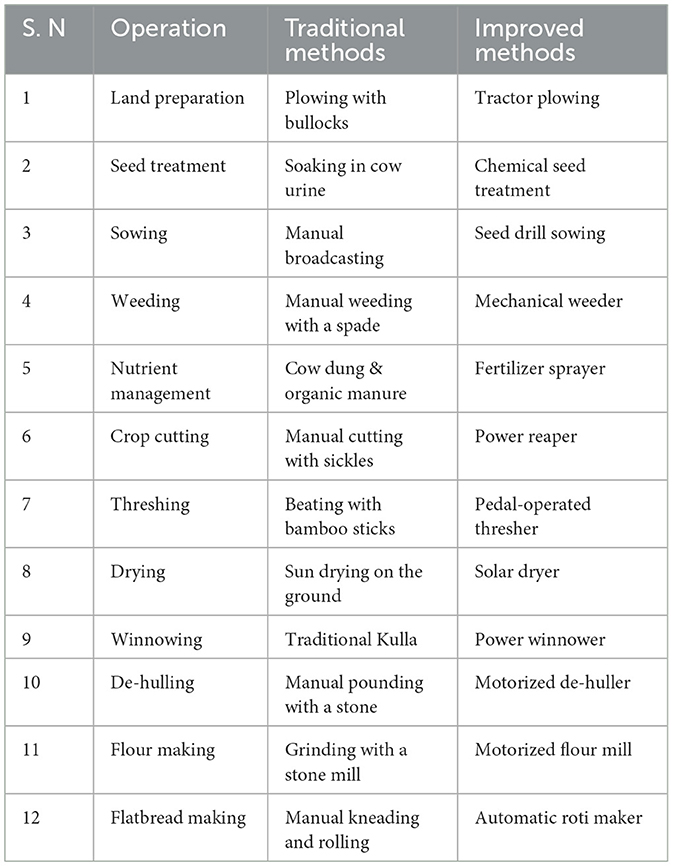
Table 2. Different practices of indigenous traditional knowledge and improved practices in millet cultivation.
3 Results
3.1 Socio-economic characteristics of millet farmers
The socio-economic characteristics of the 100 millet farmers surveyed include demographic, educational, occupational, and landholding aspects that influence agricultural decision-making and sustainability practices were identified for the study (Table 3). The results revealed that majority (66.4%) belong to Scheduled Tribes, confirming the tribal dominance in Koraput's agricultural landscape. More than half of the respondents (57.6%) were aged above 40, and only 17.6% were youth (below 30 years), indicating a generational shift away from farming. Landholding size was predominantly marginal; 72% of respondents operated less than 2 acres, consistent with national data on tribal smallholders. Notably, 63.2% of households were headed by males, but women played a primary role in post-harvest operations.
Most households relied on rainfed agriculture, and only 18.4% reported access to any form of irrigation. Education levels were low indicating 44% were illiterate, and only 9.6% had education beyond secondary school. Furthermore, 84% of respondents had annual incomes below Rs. 60,000 (Rs = Indian currency), highlighting the economic vulnerability of the population. Only 13.6% used any improved farm tools regularly, underscoring low mechanization and a dependence on traditional practices.
3.2 Indigenous Traditional Knowledge (ITK) practices in millet farming
Table 4 outlines the ITK practices adopted by the respondents. Seed treatment with ash and cow dung was widely used by 86.4% of farmers, believed to prevent pest infestation and improve germination. Traditional broadcasting of seeds, line sowing with sticks, and hand weeding were still the norm. Organic formulations such as neem leaf extracts and cow urine were commonly used for pest deterrence, showing ecological consciousness among tribal farmers (Figure 3).
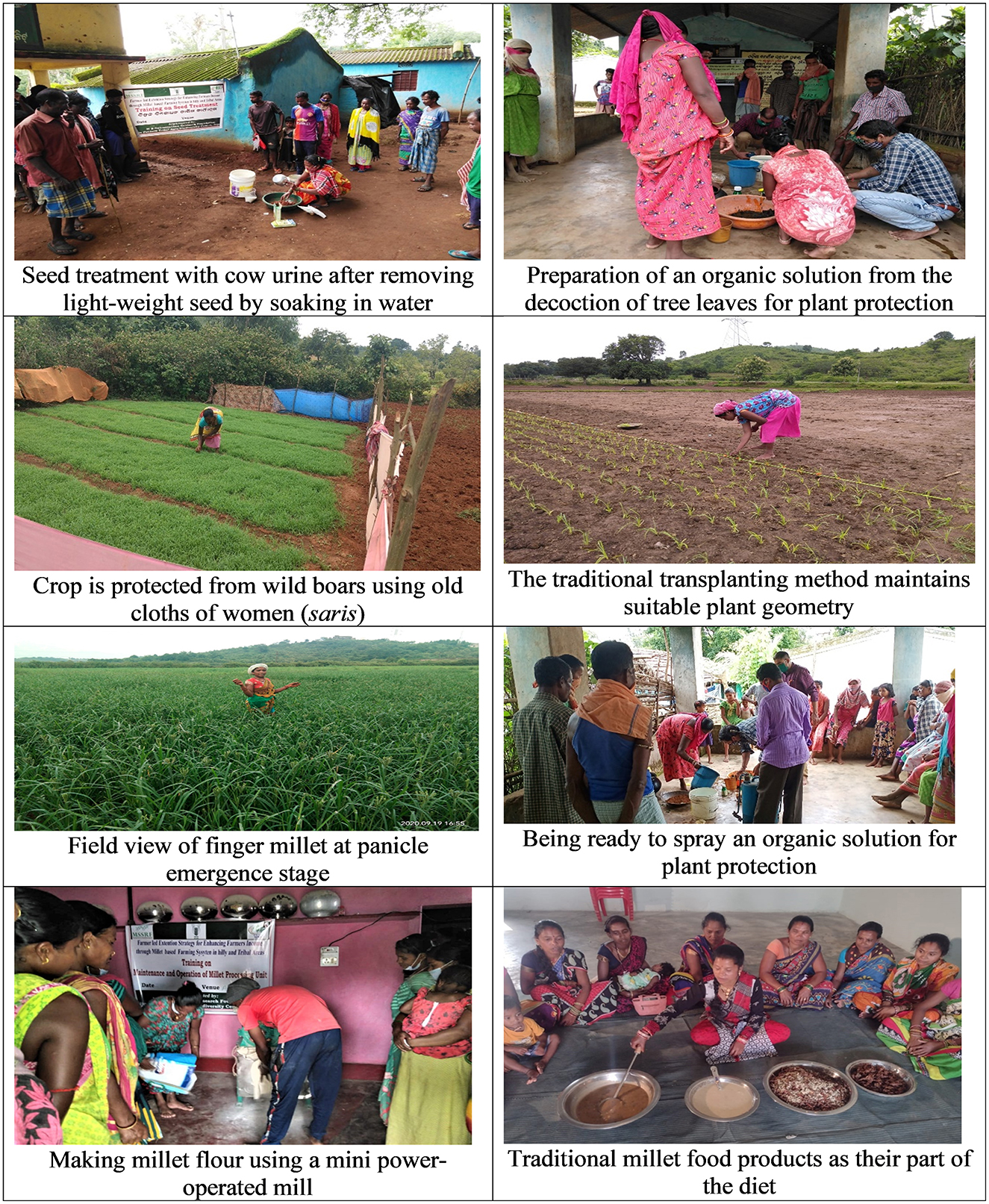
Figure 3. Different operations performed by tribal farmers in millet farming in Koraput, Odisha, India.
Post-harvest ITKs, such as sun drying, manual threshing using sticks, de-hulling by wooden pounders, and grinding on stone mills, were reported by over 70% of households. These practices are deeply embedded in cultural norms and are considered reliable, despite their labor-intensive nature. The continued use of these techniques, especially by women, reflects the embeddedness of ITK in food processing and household-level food security.
3.3 Ergonomic assessment of traditional and improved practices
Table 5 shows the calculated Human Physical Drudgery Index (HPDI) for traditional and improved post-harvest millet operations. The average HPDI for traditional threshing was found to be 27.6, indicating a “moderate to high” ergonomic risk, whereas improved mechanical threshers reduced the HPDI to 12.3. Similarly, de-hulling manually had an HPDI of 29.1 compared to 13.4 using small-scale mechanical de-hullers. Grinding millet with traditional stones showed the highest HPDI (30.2), reflecting prolonged bending posture, repetitive motion, and muscular fatigue, especially among women. Improved grinding tools halved the drudgery level (HPDI = 14.7; Figure 4). The improvement in ergonomic efficiency through basic mechanization was consistently evident across operations (Table 6), reducing the time spent, discomfort, and physical effort.
3.4 Gendered division of labor and perceived discomfort
Table 7 provides insights into the gender-wise workload distribution and perceived physical strain. Women were involved in over 90% of post-harvest operations, including de-hulling, winnowing, and grinding. More than 80% of women respondents reported moderate to severe discomfort in the back, shoulders, and hands, especially after grinding and pounding tasks. These operations were not only physically taxing but also time-consuming, with women spending 3–4 h daily during peak harvest seasons. In contrast, men were more engaged in land preparation and seed sowing. The drudgery experienced by women severely restricted their time for rest, childcare, or income-generating activities, indicating a need for gender-sensitive ergonomic interventions.
4 Discussion
The study highlights a strong reliance on Indigenous Traditional Knowledge (ITK) among tribal farmers in Koraput, Odisha, particularly in millet-based cropping systems. The findings confirm that ITKs remain not only culturally rooted but also practically effective in resource-scarce environments. However, the physical drudgery embedded within these traditional methods poses substantial ergonomic risks, especially to women who are central to millet cultivation and processing. One of the main reasons for the persistence of traditional practices, despite the availability of modern tools, lies in the low literacy levels, marginal landholding size, and limited cash income among the farming households. With 84% of the respondents earning below INR 60,000 annually and more than 44% being illiterate, there is limited exposure to formal agricultural innovation systems. As a result, farmers continue to rely on time-tested, low-cost methods using locally available resources, such as cow urine, wood ash, and manual tools. It resonates with Swain et al. (2024), who highlight how indigenous food literacy among farmers in Eastern India strongly influences the adoption and persistence of millet cultivation practices. This aligns with similar observations in tribal regions across India where formal extension systems have limited reach (Sumane et al., 2018; Singh and Gupta, 2024).
The significant role of ITKs was evident in the maintenance of soil fertility, pest and disease control, and the preservation of seed purity. Practices such as using cow dung slurry or ash for seed treatment, intercropping millets with legumes, and manual weeding not only reduce dependence on chemical inputs but also maintain soil health and ecosystem resilience (Altieri, 2018; Gupta et al., 2025). Furthermore, these methods are well-adapted to the local agro-climatic conditions, where erratic rainfall and nutrient-poor soils demand resilient farming systems. In particular, the rotational and intercropping systems observed support both biodiversity conservation and household-level food security, reflecting the multi-functionality of ITKs. Nevertheless, these traditional systems are heavily labor-intensive, particularly in post-harvest operations such as threshing, de-hulling, grinding, and winnowing. The Human Physical Drudgery Index (HPDI) revealed that operations like grinding and threshing had the highest drudgery scores. The main reasons for this are the repetitive nature of the tasks, prolonged stooping or squatting postures, and forceful manual movements using tools that are not ergonomically designed. These findings are consistent with previous studies indicating high musculoskeletal stress in traditional farming systems (Joshi et al., 2015; Nag and Nag, 2004).
The gender-disaggregated data clearly indicate that women bear a disproportionate burden of agricultural drudgery, especially in post-harvest processing. Tasks like manual de-hulling or flour making, performed daily for household consumption, result in repetitive strain injuries and fatigue. The cultural expectation that women are responsible for food preparation and seed preservation further reinforces this labor division. Such observations resonate with broader global findings where women in smallholder systems undertake the most repetitive and time-intensive tasks (UN, 2020; Ramanji et al., 2023). Despite these challenges, the introduction of improved tools and practices demonstrated a clear reduction in physical strain, as reflected in lower HPDI scores for most operations under mechanized conditions. Improved threshers, de-hullers, and grinders helped reduce processing time, posture discomfort, and force exertion—without fully replacing traditional practices. This highlights the complementary role of improved technologies, which when adapted to local contexts, can enhance productivity and reduce health hazards without undermining traditional knowledge systems (Kundu et al., 2021; Nag and Gite, 2020a,b).
However, the study also found low adoption of mechanized tools, largely due to affordability, lack of awareness, cultural preferences, and limited infrastructure for repair or maintenance. For instance, many women reported a preference for stone grinding because it produces “softer” flour and retains the grain's aroma as an insight that reveals deep cultural values associated with food processing, which mechanization must respect if it is to be widely adopted. Therefore, the strategic integration of ITKs and ergonomically improved tools offers a viable pathway toward sustainable and equitable millet farming. This requires participatory co-design of tools with end-users (especially women), localized training programs, and extension services that validate and build upon indigenous practices rather than replacing them. Such integration not only enhances ecological and economic resilience but also promotes social acceptance and ownership, which are key to long-term sustainability.
In sum, this study reinforces the view that ITKs are central to sustainable millet production in tribal areas. They provide ecological wisdom and cultural continuity, but must be supported with contextually appropriate ergonomic innovations to ensure that sustainability is not achieved at the cost of human wellbeing particularly that of rural women. The findings thus support the dual imperative of preserving local knowledge systems while addressing the ergonomic and gender-equity gaps that currently constrain their full potential.
5 Conclusion
This study addressed key gaps in understanding the role of Indigenous Traditional Knowledge (ITK) and ergonomic efficiency in sustainable millet farming among tribal communities in Koraput, Odisha. The findings reveal that ITK practices such as organic seed treatment, intercropping, and traditional post-harvest methods are ecologically sound and culturally embedded, but are also physically demanding, especially for women. Ergonomic assessment using the Human Physical Drudgery Index (HPDI) revealed that tasks like threshing, de-hulling, and grinding imposed high physical strain, contributing to long-term fatigue and musculoskeletal discomfort. Improved tools significantly reduced drudgery scores across operations, demonstrating the potential of ergonomic interventions. However, adoption remains limited due to low income, knowledge, lack of awareness, and cultural preferences. The study underscores the importance of integrating ITK with gender-sensitive mechanization to enhance productivity while safeguarding farmer wellbeing.
To this end, policy actions should focus on validating ITKs, promoting affordable tools tailored for women, establishing SHG-led and or custom hiring services of the machineries, and expanding extension services through participatory approaches. The achieving sustainability in tribal agriculture requires dual attention to traditional ecological knowledge and the reduction of labor drudgery, especially for women who are the backbone of millet systems. This integrated approach can guide future research and development programs under NFSM, Tribal Sub-Plan, and millet promotion initiatives toward more inclusive and resilient outcomes.
Data availability statement
The datasets presented in this study can be found in online repositories. The names of the repository/repositories and accession number(s) can be found in the article/supplementary material.
Ethics statement
Written informed consent was obtained from the individual(s) for the publication of any potentially identifiable images or data included in this article.
Author contributions
RC: Writing – original draft, Methodology, Conceptualization, Writing – review & editing. CS: Writing – review & editing, Project administration. KB: Data curation, Investigation, Writing – review & editing, Formal analysis. PL: Data curation, Formal analysis, Writing – review & editing, Investigation, Software, Methodology.
Funding
The author(s) declare that financial support was received for the research and/or publication of this article. Rajendra R. Chapke received funding from ICAR- National Agricultural Science fund (NASF), New Delhi, India under grant number F. No. NASF/SS-8012/2019-20.
Acknowledgments
The authors are thankful to the farmers who volunteered for the study against various odds. The authors are grateful for the managing authorities of the village for providing necessary facilities to conduct the study. The support received from the M.S. Swaminathan Research Foundation (MSSRF), Chennai as collaborator to conduct this study at village level is duly acknowledged. The authors are grateful to the ICAR-National Agricultural Science Fund (NASF) for funding support to conduct this study and Odisha Millets Mission (OMM) project for publication.
Conflict of interest
The authors declare that the research was conducted in the absence of any commercial or financial relationships that could not be construed as a potential conflict of interest.
Generative AI statement
The author(s) declare that no Gen AI was used in the creation of this manuscript.
Any alternative text (alt text) provided alongside figures in this article has been generated by Frontiers with the support of artificial intelligence and reasonable efforts have been made to ensure accuracy, including review by the authors wherever possible. If you identify any issues, please contact us.
Publisher's note
All claims expressed in this article are solely those of the authors and do not necessarily represent those of their affiliated organizations, or those of the publisher, the editors and the reviewers. Any product that may be evaluated in this article, or claim that may be made by its manufacturer, is not guaranteed or endorsed by the publisher.
References
Altieri, M. A. (2018). Agroecology: The Science of Sustainable Agriculture. Boca Raton, FL: CrC press. doi: 10.1201/9780429495465
Anitha, R., Singh, B. K., and Afifa, J. (2019). An evaluation of drudgery-reducing agricultural technologies developed for farm women. Int. J. Agric. Sci. Res. 9, 35–42. doi: 10.24247/ijasrapr20195
Banerjee, P., Maitra, S., and Banerjee, P. (2020). The role of small millets as functional food to combat malnutrition in developing countries. Indian J. Nat. Sci. 10, 20412–20417.
Directorate of Agriculture and Farmers' Empowerment Government of Odisha. (2025). Odisha Agriculture Statistics 2023–24. Bhubaneswar: Directorate of Agriculture and Farmers' Empowerment, Government of Odisha.
Dubey, P. K., Chaurasia, R., Pandey, K. K., Bundela, A. K., Singh, A., Singh, G. S., et al. (2023). Double transplantation as a climate resilient and sustainable resource management strategy for rice production in eastern Uttar Pradesh, north India. J. Environ. Manage. 329:117082. doi: 10.1016/j.jenvman.2022.117082
Dubey, P. K., Singh, A., Chaurasia, R., and Pandey, K. K. (2021). Fostering nature-based solutions for ecorestoration and attaining united nations sustainable development goals. J. Clean. Prod. 298:126680. doi: 10.1016/j.jclepro.2021.126680
Dubey, P. K., Singh, A., Merah, O., and Abhilash, P. C. (2022). Managing agroecosystems for food and nutrition security. Curr. Res. Environ. Sustain. 4:100127. doi: 10.1016/j.crsust.2022.100127
FAO (2021). The Role of Millets in Climate-Smart Agriculture. Rome: Food and Agriculture Organization of the United Nations.
Garnett, T., Appleby, M. C., Balmford, A., Bateman, I. J., Benton, T. G., Bloomer, P., et al. (2013). Sustainable intensification in agriculture: premises and policies. Science 341, 33–34. doi: 10.1126/science.1234485
Giller, K. E., Delaune, T., Silva, J. V., van Wijk, M., Hammond, J., Descheemaeker, K., et al. (2021). Small farms and development in sub-Saharan Africa: farming for food, for income or for lack of better options? Food Secur. 13, 1431–1454. doi: 10.1007/s12571-021-01209-0
Godfray, H. C. J., Crute, I. R., Haddad, L., Lawrence, D., Muir, J. F., Nisbett, N., et al. (2010). The future of the global food system. Philos. Trans. R. Soc. Biol. Sci. 365, 2769–2777. doi: 10.1098/rstb.2010.0180
Government of Odisha (2014). Odisha Economic Survey 2013–14. Bhubaneswar: Government of Odisha. Available online at: https://pc.odisha.gov.in/sites/default/files/2020-03/Economic_Survey_2013-14.pdf (Accessed September 18, 2025).
Gupta, S., Kumar, N., Satyavathi, C. T., Kancheti, M., Hazra, K. K., Hashim, M., et al. (2025). “Resource-efficient and environment-friendly production of pulses and millets,” in Advances in Agri-Food Systems: Volume I (Singapore: Springer Nature Singapore), 253–272. doi: 10.1007/978-981-96-0759-4_14
Joshi, P., Jethi, R., Chandra, N., Roy, M. L., Kharbikar, H. L., Atheequlla, G. A., et al. (2015). Ergonomics assessment of post-harvest finger millet threshing for reducing women drudgery. Indian Res. J. Ext. Educ. 15, 25–35.
Joshi, P., Mahra, G. S., Jethi, R., Satyapriya Singh, R., Bishnoi, S., et al. (2024). Ergonomics assessment of drudgery in rice-wheat production system in India: a case study of women farmers. Front. Sustain. Food Syst. 8:1346980. doi: 10.3389/fsufs.2024.1346980
Kundu, T., Kumar, M., Joshi, P., Bharadwaj, A., Marwaha, S., Pal, S., et al. (2021). Development and validation of mobile based decision support system for Human Physical Drudgery Index (HPDI). Indian J. Agric. Sci. 91, 1165–7. doi: 10.56093/ijas.v91i8.115805
Ludovic, N. J., Ousmane, M., and Saidou, I. (2020). Insight into agricultural mechanization in Cameroon: case of farm operators, users of agricultural equipment and machines. Int. J. Eng. Res. Sci. 6, 1–10.
Mekouar, M. A. (2023). Food and Agriculture Organization of the United Nations (FAO). Yearb. Int. Environ. Law 34:yvae031. doi: 10.1093/yiel/yvac040
Nag, P. K., and Gite, L. P. (2020a). “Engineering anthropometry of farmworkers,” in Human-Centered Agriculture: Ergonomics and Human Factors Applied (Singapore: Springer Singapore), 115–145. doi: 10.1007/978-981-15-7269-2_6
Nag, P. K., and Gite, L. P. (2020b). “Ergo-design criteria for farm tools and machinery,” in Human-Centered Agriculture: Ergonomics and Human Factors Applied (Singapore: Springer Singapore), 275–299. doi: 10.1007/978-981-15-7269-2_11
Nag, P. K., and Nag, A. (2004). Drudgery, accidents and injuries in Indian agriculture. Ind. Health 42, 149–162. doi: 10.2486/indhealth.42.149
Patil, P. B., Goudar, G., Preethi, K., Rao, J. S., and Acharya, R. (2023). Millets: empowering the society with nutrient-rich superfoods to achieve sustainable development goals. J. Drug Res. Ayurvedic Sci. 8, S100–S114. doi: 10.4103/jdras.jdras_207_23
Rajan, A., Boopathy, B., Radhakrishnan, M., Rao, L., Schlüter, O. K., Tiwari, B. K., et al. (2023). Plasma processing: a sustainable technology in agri-food processing. Sustain. Food Technol. 1, 9–49. doi: 10.1039/D2FB00014H
Ramanji, R. S., Sarkar, A., Mhatre, C. S., and Argade, S. D. (2023). Assessing drudgery perceived by agricultural labourers in Chikkaballapur district of Karnataka. Int. J. Econ. Plants 10, 149–154. doi: 10.23910/2/2023.0506b
Sam, B., and Kathirvel, K. (2008). Assessment of postural discomfort during power tiller operation. AMA Agric. Mechanization. Asia Africa Latin Am. 39:14.
Sanabada, A., Sa, B. S., and Patnaik, A. (2025). Millet production, challenges and opportunities – a case study of Koraput district. Int. J. Creat. Res. Thoughts 13, 1–10. ISSN 2320-2882.
Saraogi, S., Shweta, S., Rai, M. K., and Kaushik, S. (2025). “Traditional agricultural knowledge for sustainable production,” in Indian Agriculture: Challenges, Priorities and Solutions (Singapore: Springer), 319–336. doi: 10.1007/978-981-96-5273-0_15
Sarita, E. S., and Singh, E. (2016). Potential of millets: nutrient composition and health benefits. J. Sci. Innov. Res. 5, 46–50. doi: 10.31254/jsir.2016.5204
Singh, A., and Gupta, A. (2024). “Food security through sustainable agriculture: a prospective study in the indian context,” in Sustainability and Health Informatics: A Systems Approach to Address the Climate Action Induced Global Challenge (Singapore: Springer Nature Singapore), 155–182. doi: 10.1007/978-981-97-6706-9_8
Singh, A. K., and Rana, R. (2019). Nationally important agricultural heritage systems in India: need for characterization and scientific validation. Proc. Indian Natl. Sci. Acad. 85, 229–246.
Soumya, S. L., Rithika, P., Nayana, P. P., Sunny, N., Thomas, N. A., Rijul, K. K., et al. (2025). Exploring farmers' indigenous knowledge associated with millet cultivation: a case study of Millet Village in Attappady, Kerala, India. Genet. Resour. Crop Evol. 1−25. doi: 10.1007/s10722-025-02436-6
Sumane, S., Kunda, I., Knickel, K., Strauss, A., Tisenkopfs, T., des Ios Rios, I., et al. (2018). Local and farmers' knowledge matters! How integrating informal and formal knowledge enhances sustainable and resilient agriculture. J. Rural Stud. 59, 232–241. doi: 10.1016/j.jrurstud.2017.01.020
Swain, P. S., Pradhan, A. K., and Sarker, P. K. (2024). Assessing the impact of the indigenous farmers' food literacy on millet production: evidence from Eastern India. Socio-Ecol. Pract. Res. 6, 483–501. doi: 10.1007/s42532-024-00201-0
Tripathi, K., Sharma, J., Dubey, S., Gautam, U., and Parvez, R. Arya S. (2018). Participatory diagnosis of drudgery perceived by the women farmers: a micro level analysis. J. Community Mobilization Sustain. Dev. 13, 301–307.
UN. (2020). Women's Role in Sustainable Agricultural Practices and Drudgery Reduction. New York, NY: United Nations.
Keywords: drudgery reduction, ergonomic efficiency, gender, indigenous traditional knowledge, sustainable millets farming, tribal agriculture
Citation: Chapke RR, Satyavathi CT, Babu KS and Laxmiprasanna P (2025) Integrating indigenous traditional knowledge and ergonomic efficiency for sustainable millets farming: a study from Koraput, Odisha, India. Front. Sustain. Food Syst. 9:1673772. doi: 10.3389/fsufs.2025.1673772
Received: 26 July 2025; Accepted: 12 September 2025;
Published: 01 October 2025.
Edited by:
Pradeep K. Dubey, Banaras Hindu University, IndiaReviewed by:
E. Shirin Hima Bindu, Professor Jayashankar Telangana State Agricultural University, IndiaM. Deepa, KVK Guntur, India
Partha Sarathi Swain, Indian Institute of Technology Dhanbad, India
Copyright © 2025 Chapke, Satyavathi, Babu and Laxmiprasanna. This is an open-access article distributed under the terms of the Creative Commons Attribution License (CC BY). The use, distribution or reproduction in other forums is permitted, provided the original author(s) and the copyright owner(s) are credited and that the original publication in this journal is cited, in accordance with accepted academic practice. No use, distribution or reproduction is permitted which does not comply with these terms.
*Correspondence: Rajendra R. Chapke, Y2hhcGtlQG1pbGxldHMucmVzLmlu
 Rajendra R. Chapke
Rajendra R. Chapke C. Tara Satyavathi
C. Tara Satyavathi K. Srinivasa Babu
K. Srinivasa Babu Peddiveeti Laxmiprasanna
Peddiveeti Laxmiprasanna